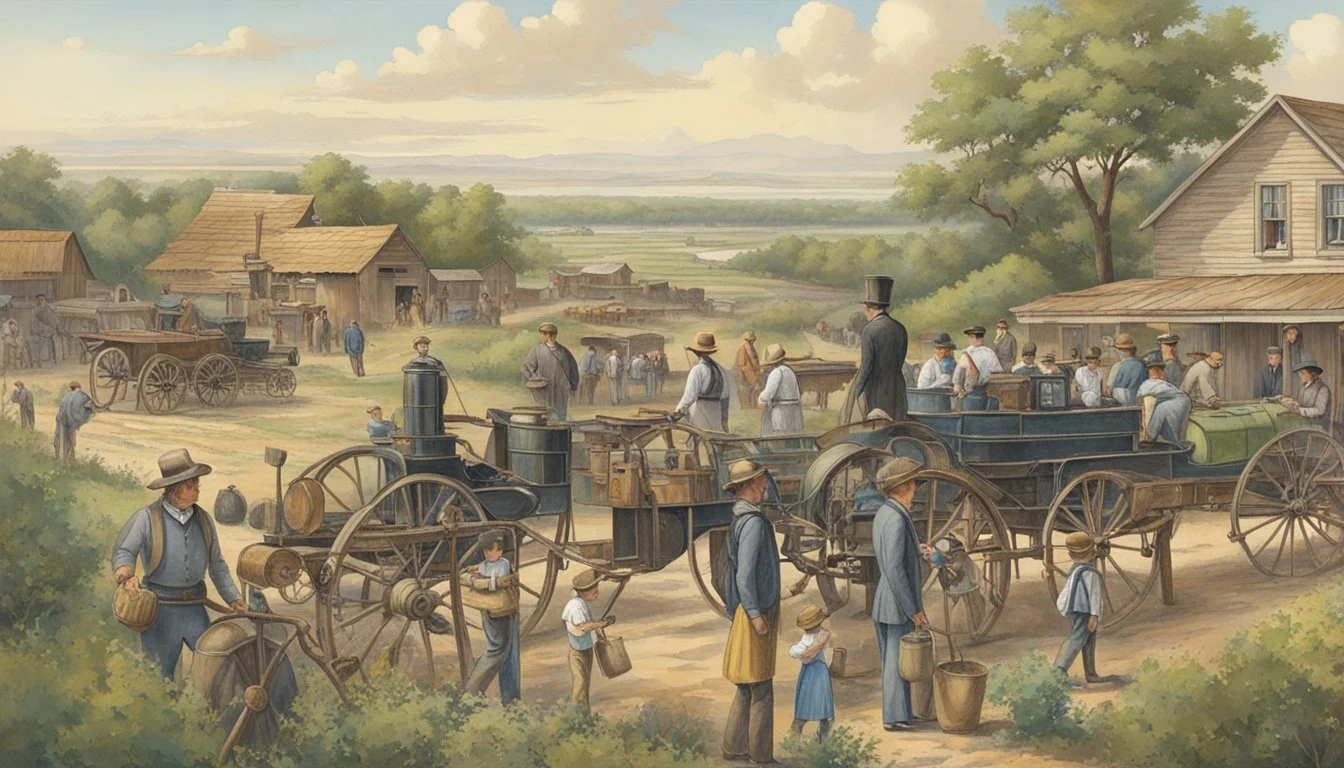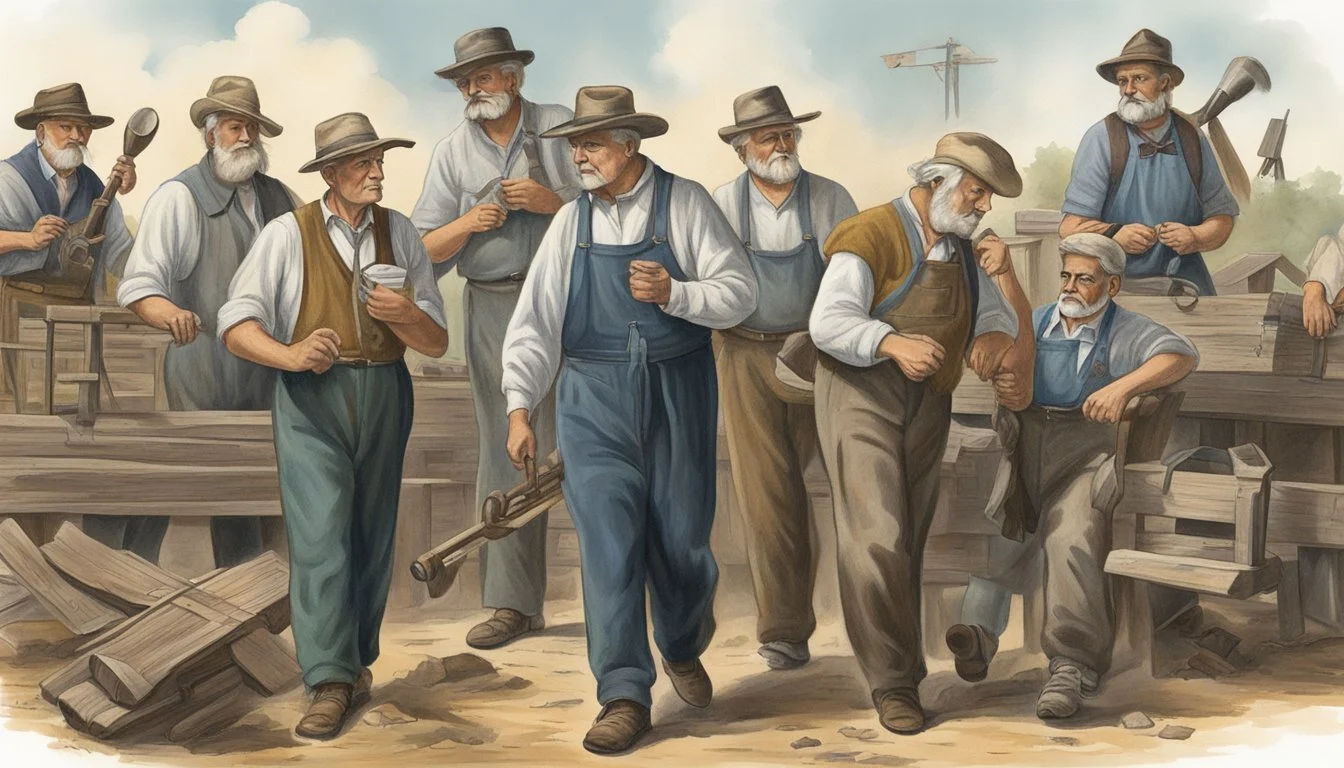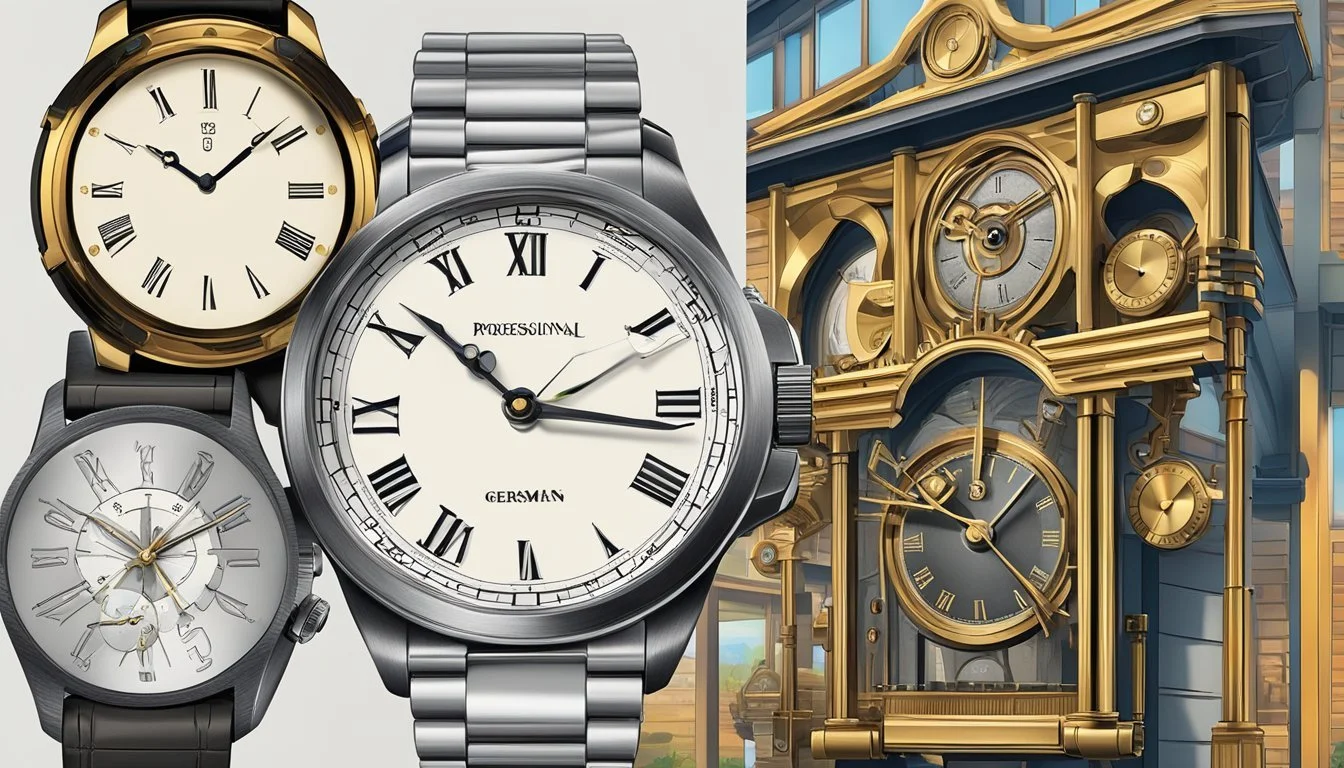The Impact of German Immigrants on Texas Watchmaking and Clockmaking
A Historical Synopsis
German immigration has contributed significantly to the cultural and industrial landscape of Texas, with one niche yet notable aspect being the advancement of watchmaking and clockmaking in the region. During the 19th century, a substantial migration of German craftspeople brought sophisticated skills in precision mechanics and engineering to Texas. Their expertise in horology complemented the already diverse set of trades and professions they introduced to their new home, a trait characteristic of the German communities established across the state.
The infusion of German expertise in timekeeping devices coincided with a developing Texas where such skills were in demand. As communities spread out across the expansive Texan landscape, the need for reliable timekeeping became apparent. German immigrants, recognized for their meticulous craftsmanship, met this need by establishing workshops and businesses that produced and repaired watches and clocks, thereby embedding their technical prowess within the burgeoning Texan economy.
This technical acumen not only enhanced the daily lives of Texans via the maintenance of personal timepieces but also played a role in the broader spheres of industry and railway management, where precise timekeeping was essential. As Texas evolved from a largely agricultural society to a more industrially complex economy, the German contribution to the field of horology ensured that local infrastructure kept pace with the technical requirements of modernization, marking an indelible influence of German immigrants on the State's development.
Historical Background of German Immigration to Texas
German immigration played a significant role in shaping the cultural and social landscape of Texas, particularly through early settlements, migration waves, and the formation of German-Texan communities.
Early Settlements and Prominent Figures
In the early 19th century, Johann Friedrich Ernst became the first German to obtain land in Texas, leading to the migration of other German families. These early German settlers established communities, with Ernst writing America letters to friends and family in Germany, extolling the virtues of Texas living. This correspondence played a crucial role in promoting further migration to the region.
German Immigration Waves
The socio-political climate in Germany and the promising opportunities in Texas led to several waves of German immigration, especially between 1844 and 1847, when more than 7,000 Germans migrated, facilitated by the Adelsverein, also known as the German Emigration Company. This organization aimed to establish new territories by promoting and managing the migration and settlement of German nationals in Texas.
German-Texan Communities Formation
Settlers founded notable German-Texan communities in New Braunfels and Fredericksburg, among others. These towns became part of the "German Belt," a term used to describe the region in Central Texas with significant German influence. Ports like Galveston served as critical entry points for immigrants, with Texas being a preferred destination due to reports of a welcoming environment and the potential for prosperity.
Economic Contributions and Industries
German immigrants significantly influenced Texas's economy through their involvement in agriculture, urban development, and specialized crafts such as watchmaking and clockmaking.
Agricultural Advancements
German settlers played a pivotal role in enhancing Texas's agricultural sector. They introduced advanced European farming techniques and cultivars, which led to the prosperity of vineyards and the growth of agricultural towns. Boerne and Schulenburg, among others, are lasting testaments to their agricultural entrepreneurship. In Boerne, the utilization of land grants permitted the establishment of thriving farms and contributed to the area's stability and growth.
Founding of Texan Towns
Industry and urban development roared to life in Texas partly due to the influence of German immigrants. Seeking religious freedom and economic opportunity, they established significant settlements. The foundations laid by German settlers in Texas echo through the generations as these towns maintain their distinctive heritage and play an essential role in the state's cultural and economic landscape.
Impact on the Texas Watchmaking and Clockmaking
Although Texas might not be universally recognized for watchmaking and clockmaking, German immigrants' precision skills greatly contributed to these industries. They brought their expert craftsmanship and opened up shops where they serviced and created timepieces. The legacy of their work is a testament to the meticulous nature of German craftsmanship and the contributions these artisans made to the local economy through their specialized trades.
Cultural Influences and Social Dynamics
The influx of German immigrants to Texas during the 19th century left a lasting imprint on the state’s horological industry, bringing with them distinctive cultural practices and fostering community bonds that led to an enduring legacy in the region’s watchmaking and clockmaking crafts.
Integration and Intermarriage
German immigrants, particularly those who arrived as political refugees, often integrated into Texan society through intermarriage with local populations. Intermarriage facilitated the blending of craft skills and the establishment of watchmaking businesses that combined German precision with Texan resourcefulness. These unions helped form cohesive communities where German practices in timepiece craftsmanship were maintained and evolved within the broader Texas culture.
German Music and Festivals
German Texans made significant contributions to the state's musical life. Music was integral in the community, often echoing from local watch and clock shops, and became a symbol of the synergy between workmanship and cultural identity. German Texans established various festivals:
Oktoberfest: Celebrating German food, music, and culture.
Wurstfest: A week-long festival in New Braunfels honoring German heritage, especially the tradition of sausage making.
These events often featured folk music and dances from the homeland, which watchmakers and clockmakers participated in, reinforcing their ethnic bonds.
Preservation of German Heritage
Despite the pressures of assimilation, German immigrants actively worked to preserve their heritage. They formed ethnic islands within Texas, such as New Braunfels and Fredericksburg, where the German language and traditions, including those related to horology, were actively promoted. Institutions such as schools, churches, and mutual aid societies served as centers for maintaining German customs. The legacy of these efforts is still visible in:
Educational institutions that continue to offer instruction in German crafts, including precision mechanics involved in clockmaking.
Historical societies dedicated to preserving the achievements and contributions of German Texan watchmakers and clockmakers.
Geographical Spread and Demographics
German immigrants substantially influenced Texas watchmaking and clockmaking. Their distribution across the state and demographic changes over time shed light on this impact.
Distribution of German Populations
In the early settlement periods, Germans predominantly located in central Texas counties, such as Comal County, Gillespie County, and Medina County. These populations provided a workforce skilled in various trades, including precision crafts like watchmaking.
Comal County: Known for its strong German heritage.
Gillespie County: Home to Fredericksburg, a center of German culture.
Medina County: Attracted a smaller but significant German population.
German-Texan 'Ethnic Islands'
Rural communities in these counties often functioned as 'ethnic islands,' retaining strong German cultural and linguistic traditions. This close-knit environment contributed to the preservation and transfer of specialized skills, including those related to horology.
'Ethnic Islands':
New Braunfels (Comal County): A hub for German settlers with a penchant for craftsmanship.
Fredericksburg (Gillespie County): Preserved German artisanal techniques.
Demographic Evolution Over Decades
The demographic landscape has evolved, but the legacy of the German populations in Texas persists. Census data over the decades reflect a significant portion of Texas residents claiming German descent.
Ancestry:
1990: More than a million Texans reported German ancestry.
Population: The influence of these demographics on local industries, such as clockmaking, continues to be relevant.
German immigrants have left a lasting imprint on the craft and trade of watchmaking in Texas, with their communities playing a critical role in the development and perpetuation of these skills.
Influence on Texan Industry and Technology
Following the arrival of German immigrants in Texas, the state saw remarkable contributions in the realms of watchmaking and clockmaking, notably through technological advancements and a strengthening of local manufacturing capabilities.
Technological Advancements in Watchmaking
German immigrants to Texas brought with them a tradition of precision and craftsmanship in watchmaking. This tradition translated into technological advancements within the Texan watchmaking industry. They introduced sophisticated techniques to enhance the accuracy and durability of timepieces. Detailed books and manuals they carried with them served as repositories of knowledge, laying groundwork for future innovations and enabling the sharing of watchmaking skills among Texans.
Influence on Local Manufacturing
The influence of German watchmakers extended beyond their individual workshops. They played a critical role in boosting local manufacturing as the demand for quality timepieces grew in Texas. The shift towards railroad expansion, underscored by detailed maps and transportation schedules, underscored the importance of accurate timekeeping, driving the growth of the watch and clock industry. Industry reports from the era highlight the uptick in watch and clock production facilities that incorporated German techniques, improving overall manufacturing standards within Texas.
Obstacles and Challenges Faced
German immigrants involved in Texas’s watchmaking and clockmaking industry encountered notable obstacles that required adaptation and resilience. Their experiences were marked by social and economic difficulties.
Nativism and Discrimination
German watchmakers in Texas often faced nativism and xenophobic discrimination. Because of their distinct culture and language, many natives viewed them with suspicion. During the Civil War era, many Germans in Texas opposed secession and slavery, which aligned them with Unionist sympathies. This stance exposed them to hostility and violence, as the state was part of the Confederacy and overwhelmingly supported it.
Economic Challenges
German immigrants in the watchmaking industry also grappled with significant economic challenges. The Union blockade during the Civil War disrupted trade and the import of vital materials and tools necessary for watch and clock production. Furthermore, establishing a customer base in a market with limited infrastructure and transportation could be daunting. They had to compete with established American watchmaking companies, which often led to financial strain.
Legacy and Modern Perspectives
German immigrants have left a substantial mark on Texas watchmaking and clockmaking, contributing to Texan identity and earning recognition for their craftsmanship and influence.
Contribution to Texan Identity
The cluster of German immigrants that settled in the Texas Hill Country during the 19th century brought with them a rich tradition of craftsmanship, which included watchmaking and clockmaking. This skilled trade became a hallmark of German artisans and contributed significantly to the middle-class economy in these areas. The dominance of German influence in these industries helped shape the local culture, infusing it with meticulous attention to detail and precision in craftsmanship. German Texans were known for their dominant personality traits such as reliability and punctuality, which were reflected in the quality of the timepieces they produced.
Clusters of German Immigrants: Brought craftsmanship skills including watchmaking.
Texas Hill Country: Became a center for German-Texan watchmakers.
Middle-Class Economy: Boosted by skilled German artisans.
Recognition and Commemoration
Modern-day Texas continues to recognize the contributions of its German population through various means. Nassau Street in Texas Hill Country signifies the lasting connection between Texas and Nassau, the region in Germany from which many immigrants originated. Commemorative events, historical societies, and watchmaking exhibits pay homage to the ingenuity of the German watch and clockmakers who have become an indelible part of Texas heritage.
Nassau Street: A symbol of the Texan-German connection.
Historical Societies: Preserve the German Texan watchmaking heritage.
Commemorative Events: Celebrate the contributions of German clockmakers to Texas's culture.






